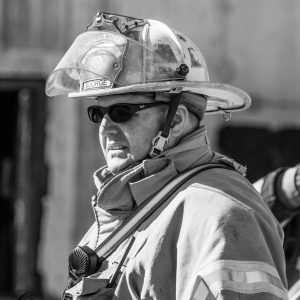It’s no secret the fire service is generally reactive to challenges. Department standard operating procedures, as well as guidelines put forth by the National Fire Protection Association, the National Institute for Occupational Safety & Health and other organizations look at negative consequences and reverse-engineer processes to try to prevent them from recurring.
This is not a bad thing. But it does tend to promote a “consequence management” philosophy rather than a risk prevention philosophy. It’s observable in our approach to challenges such as cancer prevention, leadership and mentorship, and recruiting and retention.
Today, we can add a new item to that list: firefighter mental health and wellness. Specifically, firefighter exposure to trauma. As an industry, we are aware of the problem, and progressive departments are arming their personnel with resources to help manage the cumulative stress and mental strain – compassion fatigue, burnout, depression, substance abuse, even suicidal ideation – that sometimes accompany it.
This is a noble effort, and we must continue and expand it. But we also need to challenge ourselves not to be content with reactive management of firefighter exposure to trauma. We must start to think about how to proactively reduce such exposure and its effect on our personnel in the first place.
Want to know more about Cordico, Lexipol’s wellness solution?
CLICK HERE!
The Industrial Hygiene Model
The concept of industrial hygiene goes back centuries, and although the term sounds clinical, it’s a relatively simple concept. It involves anticipating, recognizing and controlling factors that arise in the workplace that may cause workers to get sick, hurt or otherwise negatively affected.
The fire service is not new to industrial hygiene. Before the 1970s, most firefighters were not equipped with respiratory protection. As a result, firefighters frequently suffered a multitude of respiratory ailments, which cost fire departments significantly in terms of medical costs and lost time. Instead of fire service leaders saying, “Oh well, that’s just the job,” they engaged in industrial hygiene methodology. They looked at the cause – exposure to smoke – and started developing work practices to protect firefighters in environments where smoke exposure was a risk.
We need to challenge ourselves not to be content with managing firefighter exposure to trauma.
It’s no different with firefighter cancer. Cancer support networks, robust medical care, cancer presumption laws and the like are all important for helping firefighters manage a cancer diagnosis. But forward-thinking fire departments have gone further, implementing on-scene decon, equipping firefighters with multiple sets of gear, mandating showers when crews return to station after a fire, and encouraging firefighters to keep equipment and gear separate from living areas.
This same approach can be applied to firefighter mental health and wellness. We need to start asking ourselves, what are the consequences of long-term firefighter exposure to trauma and how can we start engineering work practices to reduce the exposure and the severity of exposure?
From “Post-Vention” to Resilience
We can break down our reaction to a problem into three stages. All three are important – where we go wrong is if we neglect one or more stages when allocating resources.
To illustrate these stages, let’s imagine you drive an older vehicle. One day you start to hear a noise from the motor while driving to work. You ignore the sound, but a few days later, a light on the dashboard comes on. You continue to ignore the warning signs, and a few more days go by. On your way to the station that day, the motor dies completely and your car rolls to a stop at the side of the road.
The “post-vention” stage starts when the negative consequence has occurred. In our example, this is when the car is on the side of the road, broken down. The steps we take to manage the situation – pulling over safely, calling for a tow, taking the car to the mechanic – are critical. But they are very much reactive.
The “early intervention” stage precedes post-vention. The problem has started but has not spiraled to the point of disaster yet. Early intervention involves taking steps to react to the warning signs and mitigate damage. In our example, when you first heard the motor make an unusual sound, you could take the car to the mechanic for the needed repair, preventing the breakdown.
Preceding the early intervention stage is the “resilience” stage. It involves all the activities you could be doing proactively to prevent the problem from happening. In our old-car analogy, this would include doing the recommended ongoing maintenance, perhaps even going beyond what the manufacturer requires because you recognize the car is old and more at risk for issues. It could include using a high-mileage oil or doing a special check before a long trip.
Industrial hygiene involves anticipating, recognizing and controlling factors that may cause workers to get sick, hurt or otherwise negatively affected.
When it comes to firefighter exposure to trauma, most of the fire service is still in the “post-vention” stage. We wait for the firefighter to be broken down on the side of the road – going on medical leave for PTSD, developing a substance abuse habit, even quitting the job to escape the mental strain – before we step in to help.
We must start to broaden our focus to think about what we can do in terms of early intervention and resilience. Early intervention could include tracking who’s been exposed to a critical incident, educating supervisors on the signs of trauma exposure, and providing resources to help. Resilience involves structuring daily activities and habits to maximize our ability to withstand trauma – things such as sleep, nutrition, fitness, relationships, hobbies, relaxation, mindset. It also involves systems at the department level, such as flexible scheduling and assignment and station rotation.
We Can Do Better
Critical incident stress is a known feature of the fire service workplace. As a result, it’s incumbent on fire service leaders to ask how we can engineer systems to reduce firefighter exposure to trauma. How do we better take care of our people? What are reasonable provisions we can put into place?
It’s easy to say we don’t have the time, money, resources, people. But we’ve found the resources for SCBA, turnouts, clean cabs, thermal imaging cameras, station exhaust removal – the list goes on. Is the mental health of our personnel any less important?
In future articles, we’ll explore specific steps fire departments can take to improve mental health support in the early intervention and resilience stages. Stay tuned!

